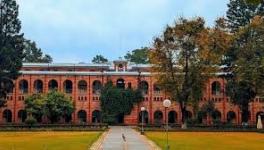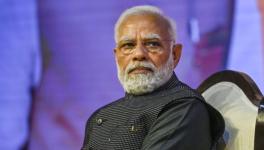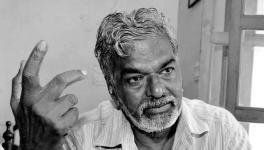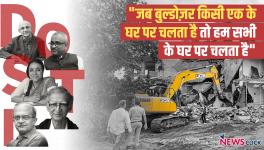No End to 'Tamas' (Darkness) Around?
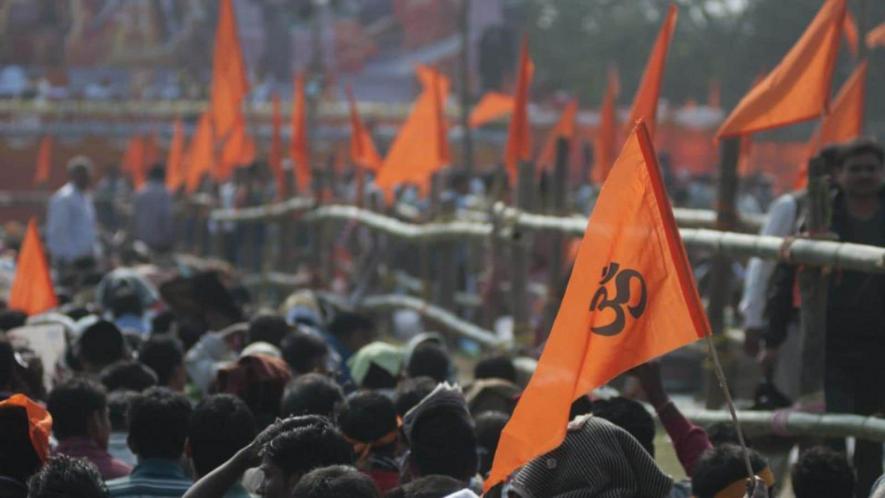
Image for representational purpose. Credit: Hindustan Times
It was the early 1970s when Bhisham Sahni, the legendary Hindi writer had penned the novel Tamas. It looks at the Hindu-Muslim riots in India in the backdrop of the Partition. Its central character is Nathu, who is Dalit and does the work of removing hides from dead animals. A local politician persuades Nathu to kill a pig; the act is later used to foment a riot in the city.
It has been more than 40 years since the novel was written, but it still resonates with today’s India as it throws light on the 'fault lines' of Indian society and shows the ease with which they can be weaponised.
Last week, a similar attempt to provoke a riot was made in Ayodhya using a similar technique; however, prompt action by the district police averted a riot there.
Eleven people from Ayodhya – who were apparently members of one ‘Hindu Yodha Sangathan’ – reportedly tried throwing prohibited meat, torn pages of a holy book, and posters with objectionable slogans before mosques and shrines of Gulab Shah Baba. The CCTV footage from near these mosques – Taatshah Jama Masjid, Masjid Ghosiyana, and Kashmiri Mohalla Masjid – when the conspiracy was executed at midnight also shows that these accused were wearing caps used by Muslims, basically to hoodwink the police and criminalise and stigmatise the community further. As of now, barring four, all other accused, namely Mahesh Kumar Mishra, Pratyush Srivastava, Nitin Kumar, Deepak Kumar Gaur alias Gunjan, Brijesh Pandey, Shatrughan Prajapati, and Vimal Pandey are behind bars.
One can imagine that if the plan to provoke riots before Eid in Ayodhya would have been successful, how it could have easily spilled over to the other parts of the country. And in a country already rocked by a hate wave – with the ruling dispensation being a mute spectator to it – it could have spelt disaster.
As per the police, apart from the 11 accused, no other person is involved at any level in this conspiracy to foment a riot. Mahesh Kumar Mishra, who has a few criminal cases already lodged against him, is the mastermind of this conspiracy, they said, adding that all of them are members of one “Hindu Yodha Sangathan”, which does not have any political affiliation.
While the police and district administration need to be appreciated for their prompt action and the vigilance shown by them, it is debatable whether this group of fanatics was acting on its own.
A quick perusal of the alleged “mastermind's” record unveils his linkages with different affiliated organisations of the ‘Hindutva Supremacist Project’, which wants to usher us into a ‘Hindu Rashtra’.
Reports tell us that he has been active in the region on various levels – organising people or taking out processions on polarising issues. He has also been found to be involved in the making of YouTube videos targeting religious minorities. As per his Twitter handle, he belonged to a leading front organisation of the Hindutva Supremacist Project. Interestingly, his brother corroborates this claim.
It is a different matter that formally, the said organisation(s) have dissociated themselves from him.
If one concedes that this group of fanatics was acting on their own, then one can see how deep this hatred for the ‘other’ has penetrated that even otherwise ordinary-looking men (from ‘lower-middle-class’ families, many of them jobless) happily joined a conspiracy which would have led to the loss of innocent lives and would have impacted their own private lives severely. We see impunity having been developed here due to which people know very well that with a sympathetic government in power, no harm will be done to them.
It further opens up the possibility of random terror acts by individuals or groups of individuals anywhere in the country, which would further widen the chasm in the country.
On the other hand, when it comes to fanatics belonging to any such exclusivist worldview, probe agencies have always discovered or talked of a long chain of functionaries: the masterminds of such conspiracies, plotters of the act, people arranging material and finances, and actual footsoldiers. We must remember that this is not the first time that a group owing allegiance to some non-descript communal organisation has tried to foment a riot. For over two decades, India has witnessed terror acts by various sectarian groups.
After the suppression of the Khalistani movement, most of such terror acts in mainland India had been attributed to Islamist groups like LeT or Jaish-e-Mohammad or SIMI, etc. This common sense around terrorism was strengthened further after 9/11 when the US launched a “war against terror” – effectively essentialising terror as an Islamist/Muslim activity.
This understanding, however, received a jolt when terror acts attributed to Hindutva formations also came to light in the first decade of this century. Recall the infamous Nanded bomb blasts (on April 6, 2006) when a bomb went off in the house of a retired irrigation department official, close to an old Hindutva formation in Nanded, Maharashtra, killing two young people – Himanshu Panse and Naresh Rajkondwar – and injuring three others. Both killed were activists of affiliated organisations. Swift action by the police initially had unearthed a sinister plot. A raid on the deceased Himanshu’s house further yielded many significant clues.
The police caught hold of maps of different mosques and also a few dresses normally worn by Muslims from the area. It found a collection of “Muslim” caps as well. The maps and the presence of “Muslim” dresses in the house of a man who belonged to the “lunatic fringe” of a Hindutva formation sent shivers down the spine of the police.
Investigating agencies could easily see that the terrorists who were inadvertently killed in the bomb blast at Rajkondwar’s house had larger plans at hand. It was the same period when BJP leader Lal Krishna Advani-led ‘Bharat Suraksha Yatra’ was entering Maharashtra. This terror module had planned some big ‘action’ in Muslim-majority areas but the timer of the bomber betrayed all their plans.
Further investigations had revealed three important things:
i) Leading lights of the Hindutva movement were in touch with them and supported them financially, materially and ideologically; ii) this terror module was involved in earlier similar incidents in the region namely Jalna, Parabhani etc where police investigation had gone cold; and iii) in the early 2000s, training camps for the use of arms and explosives etc. had been organised for many such like-minded people in Pune and other areas.
Right from the Nanded bomb blasts, Malegaon bomb blasts or Ajmer Sharief bomb blasts, Samjhauta Train bomb blasts or the blasts attributed to the activists allegedly associated with the self-proclaimed spiritual organisation from Western India, use of Muslim dresses, caps or Urdu literature, etc. to detract the investigation has been a common theme.
As an aside, we can recall how late Hemant Karkare, the then ATS chief in Maharashtra – who was martyred in 2008 – had rather singlehandedly unearthed the real culprits in the Malegaon bomb blast and sent them to jail. His investigations then had similarly witnessed the use of Urdu literature or caps worn.
It is a different matter that after 2014, when the present ruling dispensation took over, cases running in various courts were slowed down – so much so that Rohini Salian, the Public Prosecutor of Maharashtra, even told a newspaper about how she was being pressurised by an officer in the investigation department.
It needs to be mentioned there is nothing creative about the use of ‘Muslim’ dresses or impersonating Muslims by activists who yearn for a Hindu Rashtra, to deceive people or security agencies. It is a time-tested method for them.
We may want to refer to a letter here written by Dr Rajendra Prasad, who later became the first President of India, to the first home minister of independent India SardarVallabhbhai Patel. He wrote:
..I am told Hindutva activists have a plan of creating trouble. They have got a number of them dressed as Muslims and looking like Muslims who are to create trouble with the Hindus by attacking them.. ...The result of this kind of trouble amongst the Hindus and Muslims will be to create a conflagration.’’
[ Extracts of a letter, March 14, 1948, cited in Nehru-Patel: Agreement within Differences, Select Documents and Correspondence, edited by Neerja Singh, Page 43]
Param Vaibhav Ke Pathpar (Suruchi Prakashan, 1997) by Sadanand Damodar Sapre, a senior RSS functionary, talks about how after Partition, Hindutva activists “[h]ad posed to have adopted Musalman religion in order to gain the confidence of Delhi Muslim League for knowing their conspiracies”.
Apart from taking into consideration this parallel stream of fanatics, who tried to emulate the ‘other’, Ayodhya police can as well recall that more than a decade ago, similar mischievous attempts were made by Hindutva supremacist formations twice to create communal disturbances in the region.
For example, a leading figure in the Ram Mandir movement lodged a complaint with (then) Faizabad police in 2008 alleging that he is receiving death threats from SIMI and Al-Qaeda. As expected, this claim suddenly raised communal tempers in the region. To avoid any untoward incident and to catch the culprits, the district administration promptly provided the ‘leading figure’ with additional security and his mobile phone was placed under electronic surveillance to track down the miscreants.
To everyone's surprise, the police caught Ramesh Tiwari and Pawan Pandey from Katra in Gonda district – both affiliated to Hindutva formations – allegedly issuing these threats. The duo reportedly told the police that since their Guruji was not getting the Z-category security as enjoyed by other Hindutva leaders, they took this step with “Guruji's consent”. Later, it was revealed that this ‘leading figure’ had just copied one of his senior colleagues in the movement who had used a similar excuse to gain attention a year earlier.
Every peace-loving citizen who will appreciate the way Ayodhya police executed a commendable job in nabbing the culprits and avoiding a riot, would also like to see that it remains extra vigilant to avoid similar mischievous solo acts. Times are really challenging before the society and also before the institutions which have been built to safeguard the Constitution.
It would be the height of incredulity to predict that under the ruling dispensation hell-bent on disciplining the minorities in very many ways, where the use of bulldozer as a symbol of rendering (vigilante) justice has achieved typical notoriety under it, the police and other institutions would be allowed to remain unbiased.
Get the latest reports & analysis with people's perspective on Protests, movements & deep analytical videos, discussions of the current affairs in your Telegram app. Subscribe to NewsClick's Telegram channel & get Real-Time updates on stories, as they get published on our website.










